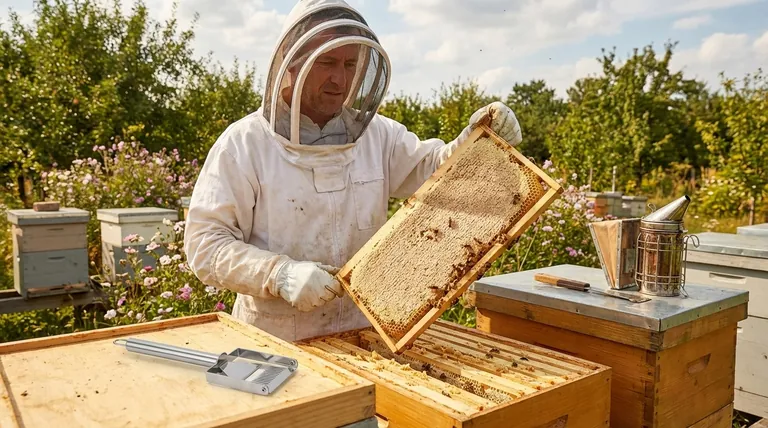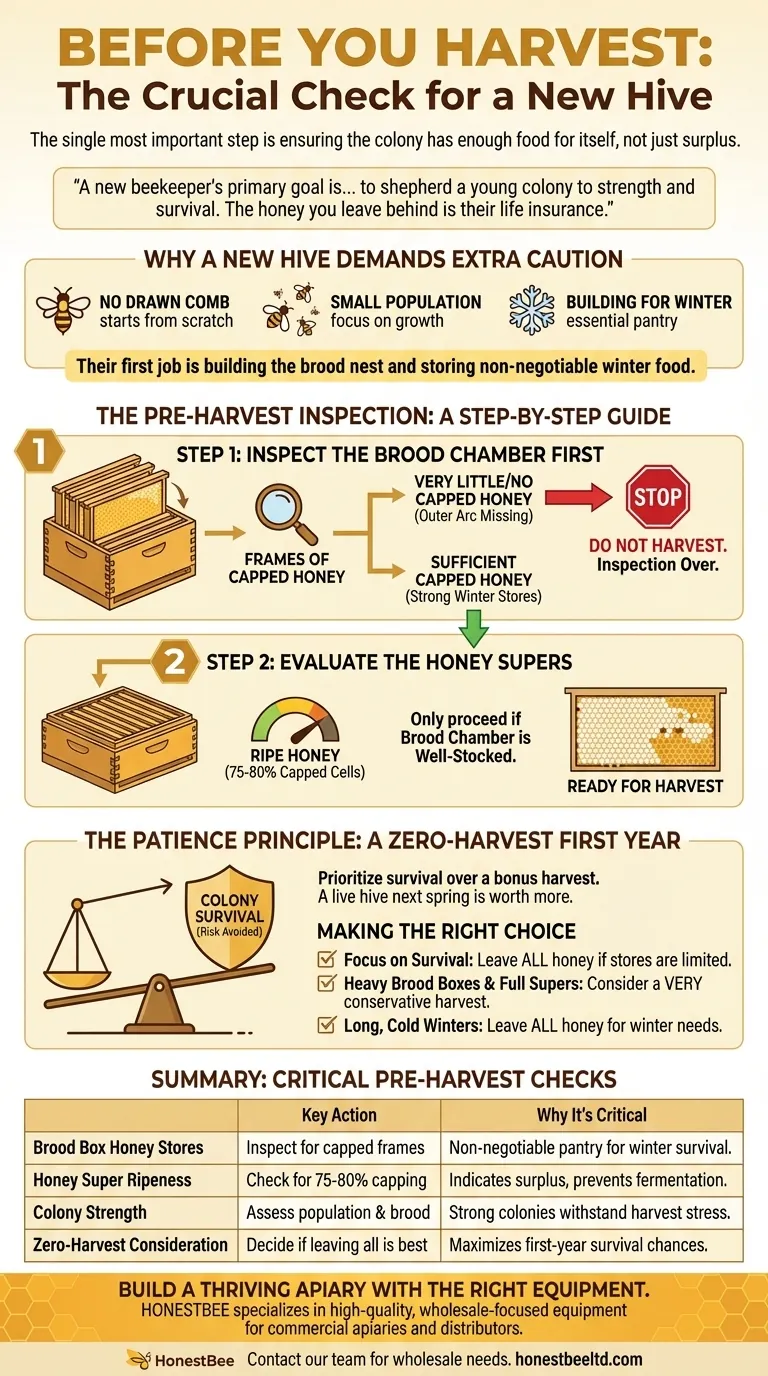Before you can harvest honey from a new hive, the single most important check is to ensure the colony has stored enough food for itself. You must inspect the brood boxes—the bees' living quarters and pantry—before even considering the honey supers above. If the brood boxes are light on stored honey, taking any from the supers puts the entire colony at risk of starvation, especially heading into their first winter.
A new beekeeper's primary goal is not to harvest honey, but to shepherd a young colony to strength and survival. The honey you take in the first year is a bonus, not an expectation; the honey you leave behind is their life insurance.

Why a New Hive Demands Extra Caution
A first-year colony operates under immense pressure. Unlike an established hive, it starts with no drawn comb, a small population, and zero stored resources. Its entire focus during the first season is on explosive growth and preparation.
The Primary Goal: Building for Winter
The bees' first job is to draw out wax comb on the frames in their brood boxes. This is where the queen lays eggs and where the colony stores the pollen and honey necessary to survive the cold months when no nectar is available.
These brood-box honey stores are non-negotiable. They are the colony's core pantry, and you must not touch them.
The Surplus Principle
Honey supers are placed on top of the hive with the hope that the bees will store surplus honey after their own needs are met. In a new hive, this "surplus" is often small or non-existent because the bees have spent so much energy building their foundational home.
The Pre-Harvest Inspection: A Step-by-Step Guide
Before you bring any equipment near the hive, you must perform a thorough inspection to gauge the colony's health and readiness.
Step 1: Inspect the Brood Chamber First
Your inspection must start at the bottom of the hive, not the top. Carefully open the brood box (or boxes) and pull out a few frames from the sides.
You are looking for frames of capped honey within this area. A strong colony preparing for winter will have a central area of brood (eggs, larvae, and pupae) surrounded by a band of pollen and then an outer arc of capped honey. If you see very little or no capped honey here, your inspection is over. Do not harvest.
Step 2: Evaluate the Honey Supers
Only if you have confirmed the brood chamber is well-stocked should you proceed to inspect the honey supers. Here, you are looking for "ripe" honey.
Bees cap honey with wax only when it has been dehydrated to the correct moisture content (around 18%). Uncapped, "wet" honey will ferment in storage. A frame is considered ready for harvest when at least 75-80% of the cells on the frame are capped over with white wax.
Understanding the Trade-offs
Deciding to harvest is a balance between your reward and the colony's risk. For a new hive, the scales are tipped heavily toward risk.
The Grave Risk of Over-Harvesting
Taking honey from a colony that has not stored enough for winter is a death sentence. The bees will consume what little they have and starve.
Even if they don't starve, a colony low on resources is a weak colony. It will struggle to generate enough heat to survive the cold and will be more susceptible to disease and pests. You risk losing the entire hive.
The Patience Principle: A Zero-Harvest First Year
It is extremely common, and often the wisest decision, for a beekeeper not to harvest any honey from a hive in its first year.
Forgoing a harvest allows the colony to use 100% of its resources to build a robust population and maximize its winter stores, dramatically increasing its odds of survival and setting it up to be a powerful honey producer in year two.
Making the Right Choice for Your Colony
Your decision should be based entirely on the results of your inspection, not on a calendar date.
- If your primary focus is colony survival: Leave all the honey, especially if you see limited stores in the brood box. A live hive next spring is worth more than a few jars of honey now.
- If your brood boxes are heavy and the supers are full: You can consider a very conservative harvest. Take only one or two of the most-capped frames and leave the rest.
- If you live in a region with long, cold winters: The most prudent choice is to leave all the honey for the bees in their first year, as their winter needs will be significant.
Prioritizing the health of your colony in its first year is the foundation for many successful harvests to come.
Summary Table:
| Pre-Harvest Check | Key Action | Why It's Critical |
|---|---|---|
| Brood Box Honey Stores | Inspect for frames of capped honey in the brood chamber. | The colony's core pantry is non-negotiable for winter survival. |
| Honey Super Ripeness | Check that 75-80% of honeycomb cells are capped with wax. | Uncapped honey can ferment; this indicates surplus is available. |
| Colony Strength | Assess population size and brood pattern. | A strong colony can better withstand the stress of harvest. |
| Zero-Harvest Consideration | Decide if leaving all honey is the best choice. | A zero-harvest first year maximizes the colony's chance of survival. |
Build a Thriving Apiary with the Right Equipment
Setting up a new hive for long-term success requires durable, reliable beekeeping supplies. HONESTBEE specializes in providing commercial apiaries and beekeeping equipment distributors with high-quality, wholesale-focused equipment—from robust brood boxes and honey supers to essential protective gear and tools.
Let us help you build a stronger foundation. Whether you're managing a few hives or a large-scale operation, having the right equipment is the first step toward a sustainable and productive apiary.
Contact our team today to discuss your wholesale needs and ensure your colonies have the best start.
Visual Guide

Related Products
- All-Stainless Steel Pivoting Honey Uncapping Fork for Beekeeping
- Stainless Steel Pivoting Honey Uncapping Fork with Plastic Handle
- Professional Honey Uncapping Roller for Efficient Harvesting
- Automatic Honey Frame Uncapper Machine for Beekeeping
- Professional Electric Honey Uncapping Knife with Heated Digital Temperature Control for Beekeeping
People Also Ask
- What is the primary use of an uncapping fork in beekeeping? A Guide to Precision Honey Harvesting
- What is the use of an uncapping fork? A Precision Tool for Hive Management and Honey Harvesting
- Why do you uncap honey? Unlock Your Harvest with Efficient Uncapping
- What to use to uncap honey? Choose the Right Tool for Your Apiary
- What are the advantages of an uncapping fork? Achieve Precision Honey Harvesting for Your Apiary



















